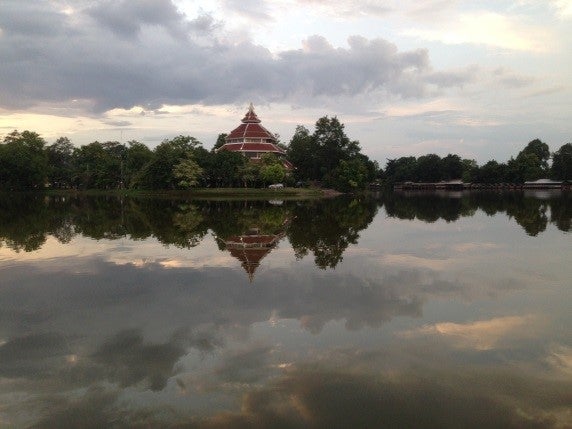New ASU study abroad programs provide more opportunity, schedule flexibility

When considering challenges such as staying on track for an on-time graduation, taking time away from family or work obligations and making a big dent in finances, the Arizona State University Study Abroad Office adopted a new program model to meet students where they are.
Similar to faculty-led programs where students take courses with an ASU professor and other ASU students, this new type of program (coined Global Intensive Experiences) bridges these gaps, and does so during seven- to 12-day academic breaks, typically winter or spring break.
With tuition packaged within the regular semester costs, these programs offer an affordable price tag (particularly since financial aid and scholarships apply) and don’t disrupt jam-packed major maps. These programs are also ideal for first-generation college students, the novice traveler or students who want to reserve their summers for internships or work.
“By offering innovative scheduling options, we can reach more students with different kinds of experiences,” said Andi Hess, study abroad program faculty director.
This past spring break, students learned about the coffee industry in Costa Rica, dove into topics related to borders and identity in Cuba and got a taste for the Peace Corps in the Dominican Republic — all while earning academic credit. Starting in 2016, there were four programs and 65 student participants. In the current year, students had three times the amount of opportunity at 12 programs, with 176 student participants, and 2018 will offer around 30 programs with spots for nearly 300 students.
The Study Abroad Office hasn’t stopped there. To offer more options for students’ schedules, spring 2018 is a pioneering time for semester-long faculty-led programs abroad, offered during sessions A and B. The goal of these programs is to provide more economically sound options for students without disrupting their academic schedules.
One of the inaugural semester faculty-led programs in Chiang Mai, Thailand (directed by ASU Professor Martin Matuštík), offers a direct look into the culture through the Southeast Asian-West Perspectives on Philosophy, Religion and Society. With the choice of six or nine credits, students will spend seven and a half weeks bookended between winter break and spring break studying death, social conflict and transformation, and cultural and gender studies.
“Spending a semester abroad is something that a student may never have time to do again. ASU offers many programs abroad, but this one is among the very few that give students a full semester-equivalent abroad and still one session back on campus,” Matuštík said.
Besides developing intercultural competence and leadership skills required to face global challenges, Matuštík noted that students will “expand in new directions, make one’s resume stand out, pursue new topics for a capstone, thesis or field experience (clinical, political-NGO, religious or social work field experience or internship).”
On the other side of the world, Hess’ session B program is another faculty-directed option to study Identity and Conflict in the Balkans.
“The semester schedule also allows students to fit study abroad into their planned academic schedule in ways many can’t during the summers due to family, work and other obligations,” she said. “Innovative options like embedded semester programs allow us to reach more students with these incredible transformative opportunities, which in turn enriches our community.”
This five-week program offers six credits for students and covers five cities in four countries across Eastern Europe.
“We will be able to engage with local people of all kinds that would otherwise be inaccessible during the busy summer months when many areas are crowded with tourists. We are also able to offer these programs to students at a lower cost when they occur during off-seasons,” Hess said.
These programs support the vision of the Study Abroad Office in providing every student with meaningful opportunities for academic and personal growth. Students can participate in programs as short as a week, as long as a year and everything in between. ASU credit is issued on all programs, and students can earn credit toward their major, minor, certificate, general education coursework or electives. Global Intensive Experiences and faculty-led programs are only two of the four program types, with partnership and exchange options readily available for students as well.
Apply to Matuštík’s program in Thailand here, or follow his Facebook page for more details. The application to Hess’ program in the Balkans is here. The deadline for these two programs is Sept. 25.
To learn more about the 250-plus study abroad programs in more than 65 different countries offered at ASU, see the Study Abroad Office website.
Top photo: The Phra Singh Temple in Chiang Mai, Thailand. Photo by Panupong Roopyai/Wikimedia Commons
More Arts, humanities and education

‘It all started at ASU’: Football player, theater alum makes the big screen
For filmmaker Ben Fritz, everything is about connection, relationships and overcoming expectations. “It’s about seeing people beyond how they see themselves,” he said. “When you create a space…

Lost languages mean lost cultures
By Alyssa Arns and Kristen LaRue-SandlerWhat if your language disappeared?Over the span of human existence, civilizations have come and gone. For many, the absence of written records means we know…

ASU graduate education programs are again ranked among best
Arizona State University’s Mary Lou Fulton College for Teaching and Learning Innovation continues to be one of the best graduate colleges of education in the United States, according to the…







